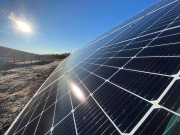2017 gave Albertans many reasons to be optimistic, including:
- Alberta securing the lowest priced renewable electricity in Canada.
The price tag is an average of $37 per megawatt-hour. - Alberta committing to phase-out the use of coal by 2030.
In less than 15 years, the province will wind down all of its coal-fired power plants. - Alberta will be generating 30 per cent of its electricity from renewable sources by 2030.
These include wind, hydro and solar projects. These are expected to attract more than $10 billion of investment in the local economy and create more than 7000 jobs during the building phase. - Alberta establishing new energy efficiency programs.
These initiatives promote the use of cutting-edge technology to reduce emissions without any changes to quality of life. They’ve created 1200 private sector jobs in 2017 and saved more than $300 million in energy costs.
Eager to continue this momentum into 2018, we asked energy and climate professionals what they’re hopeful for in the coming year:
Timur Özelsel
Associate Clinical Professor at University of Alberta Hospital
 "By 2030, Alberta will shut down all of its coal-fired power plants and will also commit to generating 30 per cent of its electricity from renewable sources. This will be such a major step forward.
"By 2030, Alberta will shut down all of its coal-fired power plants and will also commit to generating 30 per cent of its electricity from renewable sources. This will be such a major step forward.
The burning of coal is polluting and also poisoning the air we all breathe. Known substances created and released by combustion of coal are cadmium, lead, mercury, sulfur dioxide and nitrogen oxides among others. What makes many of these so dangerous to breathing organisms is that they are particulate matter – microscopic particles in the air we breathe.
The smaller they get, the more they have the capacity to cause permanent damage. Some are smaller than 2.5 micrometers. These are considered serious carcinogens and are the deadliest form of inhaled pollution.
The particulate matter can enter into the body unchecked and can clog micro-capillaries or pass into the blood-stream. This can lead to DNA mutations pre-disposing to cancer, heart strain and failure or chronic airway disease such as asthma.
As a doctor, I am hopeful that our coal phase-out will not only improve Albertans’ health dramatically, but will also prevent many diseases physicians are currently treating.
As a citizen, I look forward to running in Edmonton’s river valley on even the hottest days without worrying about dangerous levels of particulate matter in the air.
As a father, I am hopeful that my children will grow into healthy and strong adults and will be able to live lives unafflicted by illness caused by atmospheric pollution.
As a father, husband, physician and anaesthesiologist, I see hope in many things.
Thank you Government for giving me hope that economic decisions can be balanced against the needs of the population and the planet.”
Sandra Moore
Projects Consultant at Southeast Alberta Energy Diversification Strategy (SEEDS)
 “I am hopeful 2018 is the year for Alberta to shine as a leader in renewable energy, nationally and internationally.
“I am hopeful 2018 is the year for Alberta to shine as a leader in renewable energy, nationally and internationally.
Alberta is poised to see rapid growth in renewable energy with decades of innovation and experience in the petroleum industry, decreasing costs of renewable energy, increased government support and some of Canada’s best solar and wind resources (specifically near my hometown of Medicine Hat).
Renewable energy diversifies Alberta’s energy sources to support rising energy demands. These projects can supplement current businesses and create new business and employment opportunities, directly and indirectly. Renewable energy projects can increase tax bases and help cities and regions diversify their economies.
And, a bigger focus on developing renewable energy industries can spur innovation and attract investment.
The steps the Alberta government has taken in recent years makes me hopeful that in 2018 our province will be seen as a forward-thinking, innovative leader in renewable energy development and innovation.”
Megan Zimmerman
Business Development Manager at Calgary Economic Development
 “The way the world uses and produces energy is fundamentally changing.
“The way the world uses and produces energy is fundamentally changing.
If we don’t make 2018 the year we embrace pipelines and wind turbines and stop politicizing energy, then Alberta and Canada will be left in the dust.
Alberta has been the envy of Canada for decades and it will take more than $30 oil to keep us down.
Why?
Because we sit on the third largest oil reserves in the world. Our solar resource is 30 per cent greater than Germany’s. Finally, we are currently only using one-third of the land ideal for wind energy. This doesn’t even include our significant bio-energy or geothermal potential.
Alberta has limitless potential to develop, use and sell our diverse energy sources, whether it’s from natural gas or solar.
We are the only thing getting in our way! No, really.
The same entrepreneurial mindset, relentless innovation and pursuit of excellence that allowed Alberta to extract oil from sand and tap pools of oil kilometres underground, sets us up to be world leaders in energy – not just oil and gas, but energy.”
For more information on clean energy projects in Alberta, check out the Pembina Institute’s New Energy Map.
Patrick James Duke
Masters Student at University of Calgary
 “Being a millennial in the final year of my studies, I am truly excited for the prospect of joining a workforce in transition.
“Being a millennial in the final year of my studies, I am truly excited for the prospect of joining a workforce in transition.
New grads face a job market offering opportunity for growth in industries driven by new technology. I truly feel the direction I take my career will make a positive impact on Albertans, and play a role in the new global narrative of building something better.
I’m anxious to become part of the energy transition and shape the way the future is going to look. I also feel pride this new paradigm is being spearheaded by young people.
Our generation is leading so many sustainability initiatives, giving rise to the youth voice.”
Scott Crichton
Assistant Business Manager at International Brotherhood of Electrical Workers (IBEW)
 "Alberta has some of the best potential in the world to generate solar power.
"Alberta has some of the best potential in the world to generate solar power.
Since the price of solar equipment has come down so much, hundreds of electricians have expanded their expertise to include photovoltaic (PV) systems. Now the province has a fully trained workforce capable of building renewable energy projects. Plus, there is a sense of optimism that there’ll be new employment opportunities in the PV industry for electricians.
By reaching out to existing organizations like the Electrical Contractors Association of Alberta (ECAA), the IBEW and local businesses, the province can continue to meet new workforce demands.
While Alberta has an opportunity to diversify our economy, it’s important not to forget the people working on renewable energy installations must be paid a living wage. They need to be able to take care of their families and have a good quality of life.”











